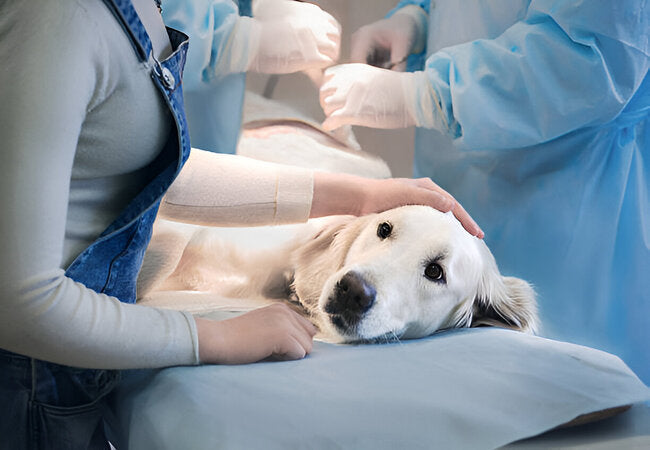Vet‑Approved 2025 Guide: Dog Surgery Aftercare FAQs – Recovery, Monitoring & Comfort 🐶💉

In this article
Vet‑Approved 2025 Guide: Dog Surgery Aftercare FAQs – Recovery, Monitoring & Comfort 🐶💉
By Dr. Duncan Houston BVSc
Post-surgery care can feel overwhelming—this comprehensive FAQ guide aims to ease your concerns. Covering topics like bowel and bladder routines, appetite, incision monitoring, pain assessment, and comfort strategies, it’s enriched with recovery tools from Ask A Vet to support a stress-free healing journey. Let’s dive in! 😊
1. 🟤 Should my dog be constipated after surgery?
Yes—it’s common. Anesthetic and pre-op fasting can delay bowel movements. Expect one within 48 hours. Watch for straining, dry stools, or vocalizing. Strategies include dietary fiber (pumpkin), increased water, prescription stool softeners, or fiber supplements as directed.
2. 🚽 Is urine leakage normal post-op?
Usually not. Dogs should urinate normally. Occasional accidents might happen if they’re in pain or unsteady. Ensure pain control and help them outside. If issues persist, consult your vet.
3. 😣 What if my dog is howling or straining to urinate?
That’s an emergency. Straining or vocalizing while peeing could indicate a urinary obstruction—seek vet care immediately.
4. 💧 Is frequent urination after surgery normal?
Yes, if IV fluids were administered—clear urine and more frequent urination in the first 48 hours is expected. But watch for signs of discomfort, blood in urine, or decreased output—these need medical attention.
5. ⛔ My dog isn’t peeing—what should I do?
Inability to urinate is life-threatening. If there’s no urination in 12–24 hours, head to the vet or emergency clinic right away.
6. 💊 What can I give for pain?
Only give vet-prescribed medications—NSAIDs, opioids, or sedatives as directed. Never give human pain meds—they’re toxic to dogs. Use cool compresses, passive range-of-motion, comfy bedding, and ensure adequate rest.
7. 🍽️ What if my dog won’t eat?
Reduced appetite for 24 hours is normal. If no interest after 24 hours, call your vet. Feeding small amounts of bland food (boiled chicken & rice) may help. Some vets prescribe special diets—check instructions.
8. 🤢 Is vomiting normal?
It’s not typical and could indicate complications from anesthesia, infection, or pain. If vomiting occurs, consult your vet—emergency care may be needed if repeated or persistent.
9. 🧷 My dog’s stitches are showing—when are they removed?
External stitches/staples are removed typically after 10–14 days. Internal sutures dissolve on their own. If stitches loosen or break early, call your vet.
10. ❗ Does my dog need a cone?
Yes—your dog should wear a cone or barrier for 10–14 days to prevent licking that can open wounds or cause infection. Options include plastic cones, soft cones, inflatable donuts, or recovery suits—choose what’s effective for your dog.
11. 🔴 What are the signs of infection?
Look for increased redness, swelling, heat, discharge (pus), bad smell, fever, lethargy, or appetite loss. Contact your vet promptly if any appear.
12. 🥶 Why is my dog shaking after surgery?
Trembling is common due to anesthesia effects or mild discomfort. For persistent or severe shaking, reach out to your veterinarian.
13. 😮 My dog had a seizure—normal?
No—seizures are not normal and may signal serious issues (toxicity, bleeding, metabolic disturbances). Seek emergency care immediately.
14. 🫁 Heavy panting or coughing?
Panting may reflect pain, stress, or anesthesia effects. Coughing may be from intubation irritation. Persistent symptoms warrant veterinary evaluation.
15. 😞 My dog seems depressed—what can I do?
Recovery stress is common. Enrich their environment with mental stimulation (food puzzles, gentle training), comforting bedding, and quiet reassurance. Ask about short-term anti-anxiety meds if needed.
16. 🤧 Runny nose after surgery?
Occasional nasal discharge from anesthesia is usually mild. Persistent or worsening symptoms should prompt a vet check.
17. 🛏️ How much rest and confinement?
Rest is essential. Keep them indoors, quiet, and crate-confined if advised. Allow controlled leash walks, restrict jumping/climbing, and use gates or crates when unsupervised.
18. 🧼 How to care for incisions?
Keep incisions clean and dry. Avoid hydrogen peroxide or alcohol. If dirty, gently clean with sterile saline. Inspect twice daily for condition, temperature, swelling, or discharge.
19. 🧩 Comfort & recovery aids
- Ask A Vet: Virtual post-op check-ins for photos, concerns, and med adjustments from home.
20. 📞 When should I call the vet?
- No bowel movement in 48–72 hours.
- No urination within 12 hours post-op.
- Persistent vomiting, diarrhea, anorexia beyond 24 hours.
- Fever, shaking, seizures, or difficulty breathing.
- Swollen, red, or open incisions.
- Persistent stress, depression, or refusing meds.
Early intervention maximizes safety and recovery success—don’t hesitate to contact your vet or use Ask A Vet!
🏁 Final Thoughts
Comprehensive aftercare—covering pain management, rest, incision checks, and behavioral observation—ensures the best outcome. Combine routine and vigilance with comfort tools from Ask A Vet, to foster a calm, supported recovery. And remember—no question is too small. Your vet, or our app, is always ready to help. Wishing your pup a speedy, smooth healing journey! 💖🐾






